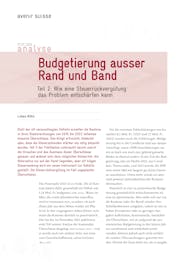In 2023, unplanned surpluses from the cantons could be rare. For the first time, the Swiss National Bank (SNB) did not distribute profits in 2023, even though cantons had budgeted for a total of CHF 1.76 billion in revenue from this source. In previous years, the opposite happened: From 2016 to 2022, cantons were far too cautious in their budgeting on average, not only regarding SNB distributions but also in terms of tax revenues.
Significantly lower taxes would have been possible
The resulting large surpluses are more welcome than deficits. However, to regard them simply as “nice surprises” is to ignore an important aspect: if the State generates too much revenue, it places too heavy of a burden on taxpayers in relation to the benefits they receive. On average for Switzerland as a whole, cantons would have achieved balanced budgets between 2016 and 2022, even with a 10 percent cut in income tax or a 5.6 percent reduction in all direct taxes.
It would be logical to require more precise budgeting to increase the potential for tax reduction. However, budgeting is a demanding process. When in doubt, being cautious is not entirely unjustified. Moreover, reservations about tax cuts are often high: What will happen if the coming years do not turn out as successful as the previous ones? Will the canton then have to raise taxes again or even implement major cost-cutting measures? This publication suggests a new tool to address these concerns.
How to introduce a tax refund
Unlike tax cuts, tax refunds do not represent a risk for the State budget and do not overburden taxpayers. If a canton were to record an unbudgeted, and therefore unplanned, surplus, it would automatically reimburse taxpayers for the overpayment.
The study discusses different ways of implementing such a tax refund. The recommendation of the author is to apply the tax refund according to the canton’s debt situation. In the case of negative net debt (financial assets exceeding third-party capital), a refund corresponding to the entire unplanned surplus is appropriate. Currently, 14 of the 26 cantons meet this criterion. For a net debt ratio (net debt/tax revenue) between 0 percent and 100 percent, a partial refund is appropriate. For ratios exceeding 100 percent, on the other hand, the focus should be on reducing the debt and, consequently, no refund will be made.
A tax refund should take the form of a percentage refund of direct taxes to taxpayers. It would be applied following the same logic as the reduction in the tax rate, which reduces the tax burden of all taxpayers by a certain percentage.
Ideally, the refund should be paid with the final tax bill sent in autumn of the following year at the earliest, when the result of the annual accounts is known. There would therefore be no need for an actual refund, only a percentage reduction in the final tax bill. Introducing such an instrument would hence be straightforward.
Conclusion
From a fiscal policy perspective, a tax refund does not represent a great risk and can be introduced to complement the debt brakes of each canton. It is a simple, quick and flexible way of involving taxpayers and service providers in the positive financial development of their canton.
Part 1 of the analysis can be found here





